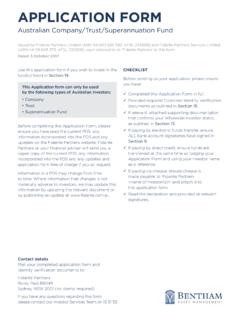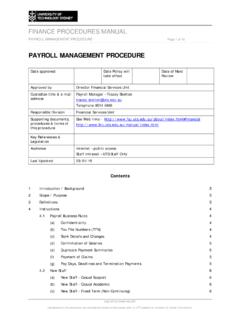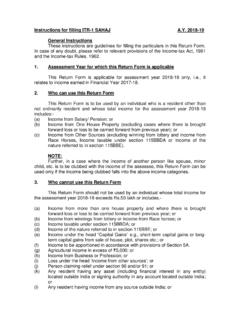Transcription of 1. What is National Pension System? - ICICI Direct
1 1. What is National Pension System? The National Pension System (NPS) is a new voluntary contributory Pension scheme introduced by the Central Government through Pension fund Regulatory and Development Authority (PFRDA) to promote old age income security. It is a defined contribution Pension system which is being offered on a voluntary basis to all citizens of India other than government employees covered by NPS. PFRDA has also introduced Corporate National Pension System model (under existing All Citizen of India Model ( commonly known as UOS NPS model )) where-in the Corporate can get itself register under the System with CRA through the recognized POP.
2 As per the Corporate NPS model the Corporate is free to offer the NPS system to all or select employees ( based on certain criteria - above a certain grade). Under the Corporate NPS model, the Corporate can transfer Employee s contribution ( deduction from employee s salary) to Employee s NPS Tier I account and it also has an option to contribute over and above the employee s NPS contribution amount. Under the NPS, individuals can open a personal retirement account with the government through PFRDA and can set aside and save a Pension corpus during their work life to meet financial needs after retirement.
3 These contributions earn returns depending on the investment option selected by the individual. NPS a c c o u n t i s a u n i q u e a c c o u n t . O n e c a n n o t h a v e m o r e t h a n 1 N P S a c c o u n t. At the time of withdrawal, the subscribers have to invest a portion of their accumulated Pension wealth under the NPS to purchase a life annuity from an IRDA regulated life insurance company and the balance may be withdrawn in lumpsum. The amount and the time period after which withdrawals can be made are subject to certain conditions (as explained in FAQs). To view the NPS offer document visit 2.
4 What is the architecture of NPS? Who are the different entities involved? Following are the Intermediaries in the NPS system: Pension fund Regulatory and Development Authority(PFRDA) Central Record-keeping Agency (CRA) National Securities Depository Limited (NSDL) has been appointed as the CRA for NPS by PFRDA. Pension Funds (PFs)/ Pension fund Managers (PFM) Annuity Service Provider (ASP) Trust & Trustee Bank (TB) Point of Presence (PoP) Custodian Description of the above entities : Pension fund Regulatory and Development Authority (PFRDA) PFRDA is the regulator for the NPS. PFRDA is responsible for registration of various intermediaries in the system such as Central Record Keeping Agency (CRA), Pension Funds, Custodians, NPS Trustee Bank, etc.
5 PFRDA shall also monitor the performance of the various intermediaries and ensure that all stakeholders comply with the guidelines/regulations issued by PFRDA from time to time. Central Record-keeping Agency (CRA) The record-keeping, administration and customer service functions for all subscribers of the National Pension System will be centralized and performed by the CRA. The CRA shall, on the basis of instructions received from subscribers, transmit such instructions to the appointed Pension Funds on a regular basis. The CRA will also provide periodic, consolidated PRAN statements to each subscriber.
6 Currently National Securities Depository Ltd (NSDL) is CRA. Pension Funds (PFs)/ Pension fund Managers (PFMs) Appointed PFs are responsible for managing the retirement savings of subscribers under the NPS. The PFRDA has appointed a limited number of leading professional firms to act as PFMs. Subscribers contribution is given to these PFMs for further investment. The PFMs are required to invest strictly in accordance with the guidelines issued by the government / PFRDA. PFMs would communicate the NAV of each scheme to CRA on a regular basis. NPS allows you to choose from any one of the following 8 entities as PF to manage your Pension fund : 1.
7 ICICI Prudential Pension Funds Management Co. Limited 2. HDFC Pension Management Company Limited 3. Kotak Mahindra Pension fund Limited 4. LIC Pension fund Ltd 5. Reliance Capital Pension fund Limited 6. SBI Pension fund Pvt. Limited 7. UTI Retirement Solutions Limited 8. Birla Sun life Pension Management Limited Annuity Service Provider (ASP) ASPs are responsible for delivering a regular monthly Pension to the subscriber if subscriber has purchased annuity scheme either before attending age of 60 years (subject to lock-in period of 10 years) or attending the normal retirement age of 60 years or on attending superannuation after attaining the normal retirement age of 60 years.
8 PFRDA has empanelled the following seven IRDA approved life insurance companies for providing annuity services to the subscribers of National Pension System (NPS). 1. Life Insurance Corporation of India 2. SBI Life Insurance Co. Ltd. 3. ICICI Prudential Life Insurance Co. Ltd. 4. Star Union Dai-ichi Life Insurance Co. Ltd. 5. HDFC Standard Life Insurance Co. Ltd. PFRDA / CRA is in process of finalizing the operational guidelines for annuity,. NPS subscriber can then annuitize the withdrawal amount through Annuity Service Provider as selected by subscriber either on attaining the 60 years of age or before attaining the age of 60 years subject to 10 years of lock-in.
9 Trust & Trustee Bank (TB) The Trust established under the NPS, is responsible for taking care of the funds under the NPS and is the registered owner of all NPS assets. The trust holds an account with as the NPS Trustee Bank, Axis Bank. NPS Trustee Bank facilitates fund transfers across various entities of NPS system viz. PFM, Annuity Service Providers, subscriber, etc. The NPS Trust is being administered by the Board of Trustees, as constituted by the PFRDA. Point of Presence (PoP) PoP is the first point of interaction between the voluntary subscriber and the NPS architecture. The PoP is responsible for performing functions relating to registration of subscribers, undertaking Know Your Customer (KYC) verification, receiving contributions and instructions from subscribers and transmission of the same to designated NPS intermediaries.
10 Custodian The Custodian is responsible for the custody of underlying assets. Custodian is a SEBI registered Custodial Services providing fulfilling condition on foreign holdings and cross holdings as Government may prescribe. Current custodian is Stock Holding Corporation of India (SHCIL) Please note that the addition or deletion of intermediaries like PFM, POP and ASP is a continuous process. The latest list of PFMs, POPs and ASPs are available on PFRDA website - 3. Who can invest in NPS? Any Indian citizen between the age of 18 to 60 years can invest in NPS. However, persons having an existing NPS account and government employees who are already covered under NPS cannot again open an additional account under NPS.










